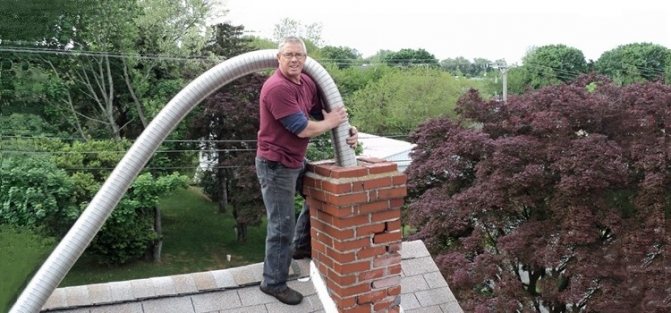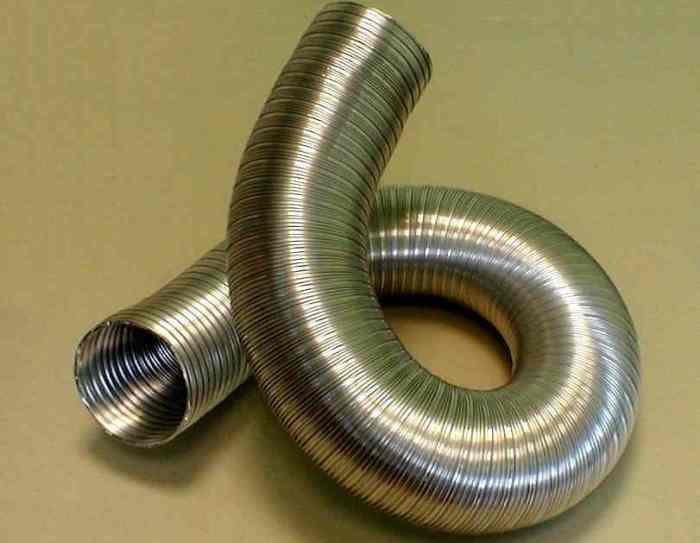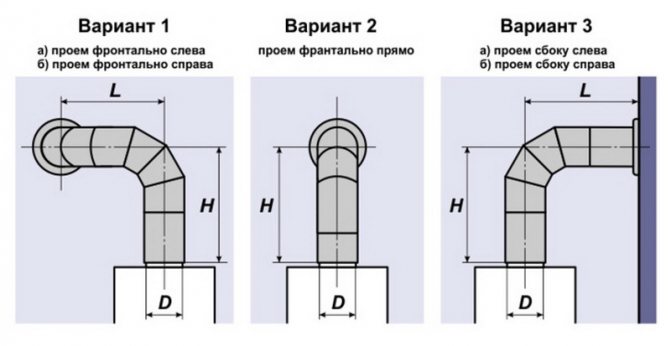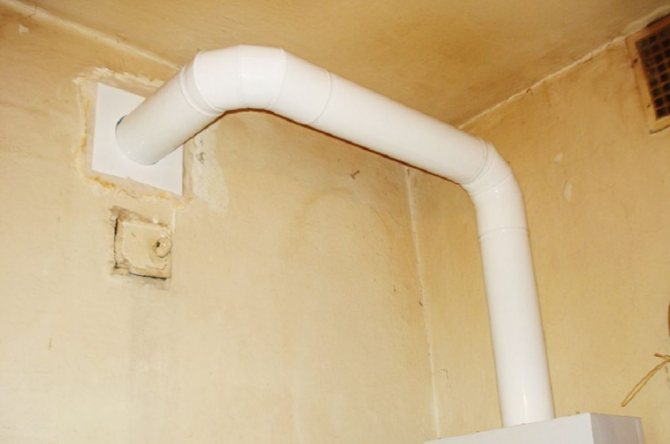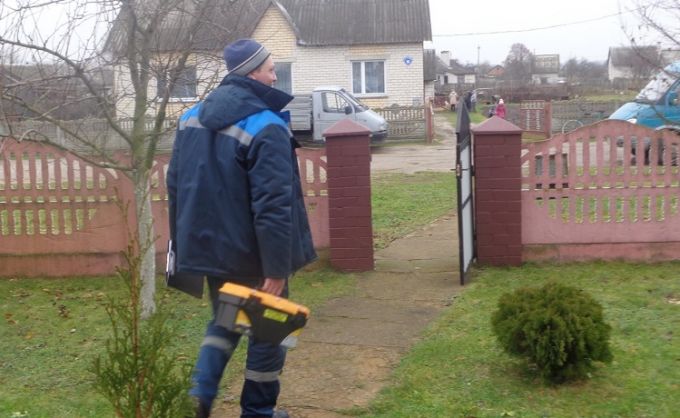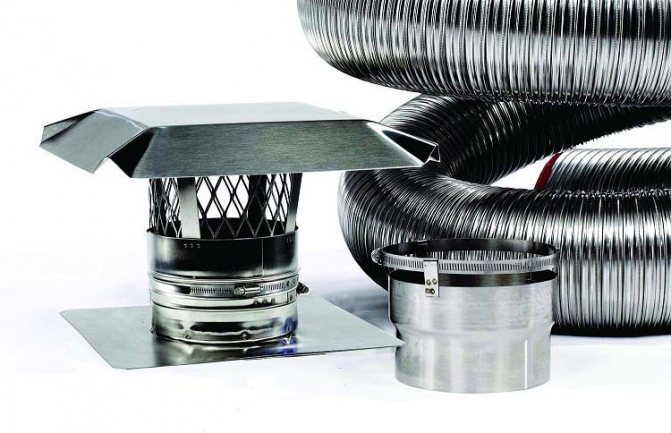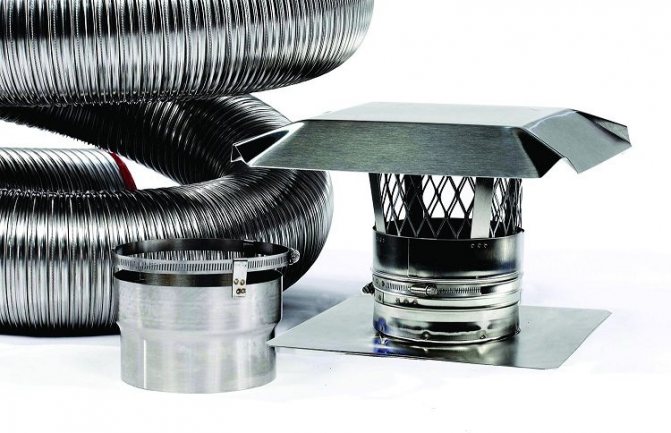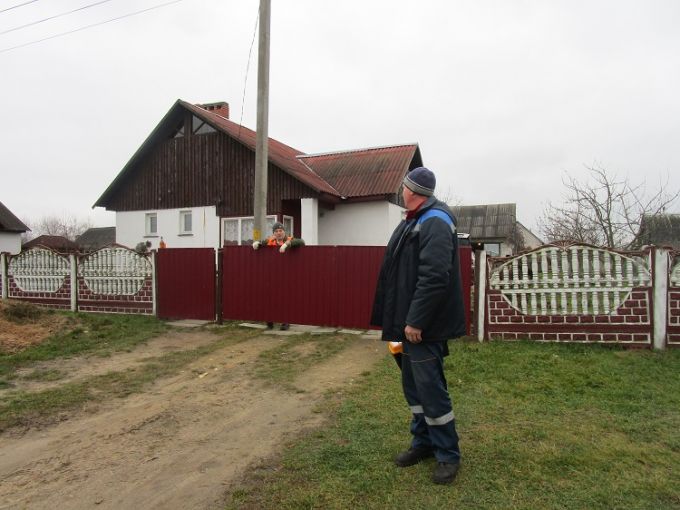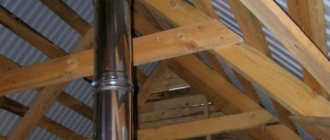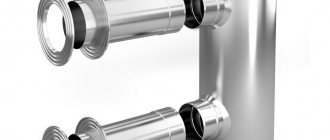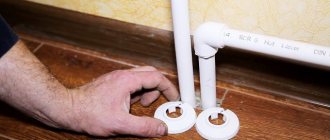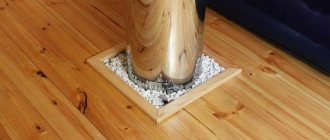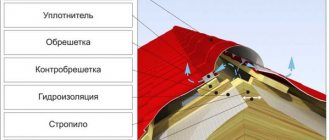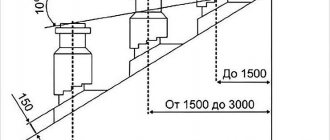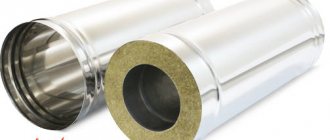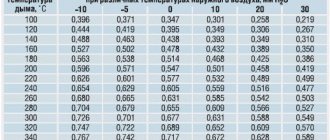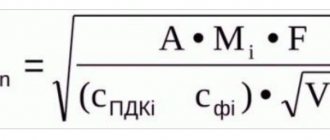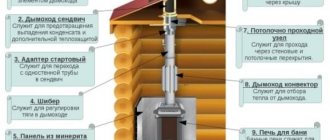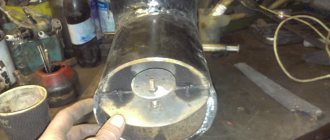When installing a gas water heater, you must consider the connection to the chimney. The removal of combustion products is an important factor in the operation of technology. A pipe is used as a connecting element between the column branch pipe and the chimney. Not sure which hood material to choose? Perhaps a corrugation for a gas column will suit you.
Advantages and disadvantages of corrugated chimney pipes
The positive aspects of using corrugation for such purposes include the following points:
- The circular section of the chimney is the most favorable for the passage of gases. The flow rises along it in a spiral, which is why stagnant zones are created in the corners of a square or rectangular channel, in which moisture present in the smoke is actively condensing. It becomes a "trap" for unburned fine fuel particles. This mixture becomes soot, which can block the smoke channel completely, making it impossible for the further operation of the heating unit in the house.
- Simple docking of individual elements of the chimney. A simple adapter and a pair of clamps are sufficient for this.
- Simple and affordable repair associated with simple dismantling and easy assembly of the new flue duct.
- The need for various components is minimal, since corners, turns and other similar elements are not used.
- Convenience of laying a chimney with direction changes if you need to bypass obstacles in the form of rafters and other structural elements.
At the same time, there are several negative aspects of their use:
- Small wall thickness (0.1 mm), which leads to active cooling of the chimney and is accompanied by the formation of a large amount of condensate, and therefore soot. The flue duct made of heat-resistant corrugation needs careful and high-quality insulation.
- Roughness of the inner surface of the corrugation walls, contributing to the increased formation of condensation and soot.
Most often, corrugated pipes are used to insert a liner into brick or other channels in the shape of a rectangle,
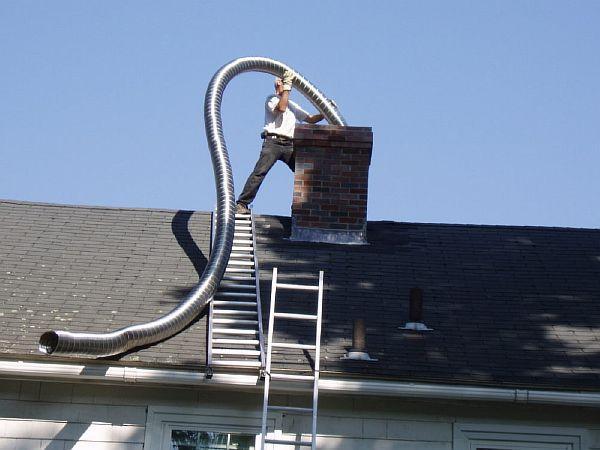
as well as in the places where the boiler is connected to the smoke exhaust duct.
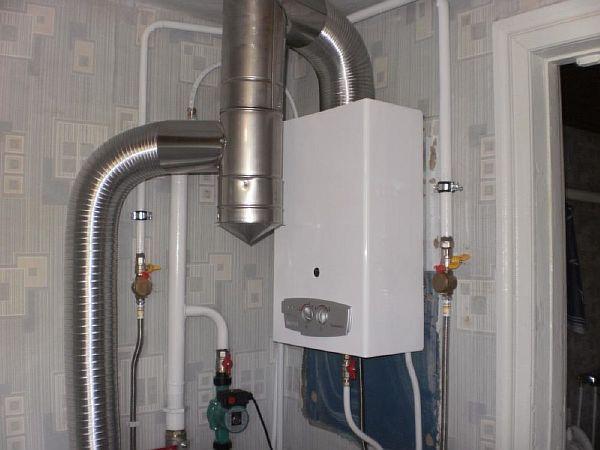

Chimney assembly and installation
Correct installation of the chimney will ensure high-quality smoke extraction, increase the efficiency of gas equipment and prevent the possibility of fire, carbon monoxide leakage.
Installation starts from the gas column. Typically, the build process includes the following steps:
- We mount the pass-through pipe into the wall, through which we will conduct a pipe to remove smoke. We set the turn to go to the outer, vertical part of the system. We attach the pipe to the outlet of the column.
- We mount the chimney pipe on the outer wall. This is done by placing one structural element in another. The joints on the pipes are fixed with clamps.
- We distribute the brackets supporting the structure along the entire length of the chimney. The step between the brackets should be in the order of two meters. When securing the system, the main attention should be paid to the absence of pipe deflections. They should not be along the entire length. We install the protective head. An umbrella that prevents rainfall from getting inside. In the lower part of the vertical section of the structure, we fix the revision window.
- Upon completion of the work, be sure to check the draft. For this we take a box of matches. We bring a lit match to the chimney. The fire from the source of combustion will tilt to the side, this indicates the presence of thrust.
Malfunctions arising during the operation of the chimney system:
- Incorrect installation of the fume extraction system or the use of poor quality materials when using the flue gas vent can lead to burnout.
- Improper use of the gas water heater leads to a fire. The soot ignites.
- Poor thermal insulation leads to the formation of a large amount of condensation.
- The reason for poor draft is the wrong design of the chimney, poor selection of thermal insulation.
The chimney must be of high quality, you should entrust its installation to specialists.
Thanks to this, you can not only enjoy a reliable smoke extraction system, but also preserve your health.
14 Feb 2013, 08:54
People, from what to make a connection to the hood for a gas water heater? There are stainless corrugations on sale, but they are expensive and there are ventilation corrugations - aluminum. I don’t know if the column exhaust will burn aluminum, because it melts at a temperature of only 660C. And the flame temperature exceeds 1000C.
14 Feb 2013, 09:10
This is a common misconception. Although the flame temperature is about 1300C, the temperature at the exhaust drops sharply to 200-300C. This is quite normal, aluminum holds well. The farther from the gas water heater.
The temperature is, of course, lower. At the entrance to the ventilation, it does not exceed 100C at all.
You do not have the required permissions to view the attachments in this post.
The procedure for installing a chimney for a gas boiler
The manufacture of chimneys for gas heating devices using a corrugated pipe is popular. In this case, a heat-resistant aluminum corrugation can be used. At the same time, the basic requirements for the smoke exhaust device remain the same:
- reliability;
- durability;
- tightness throughout the entire service life.
The chimney consists of the following elements:
- The pipe is crowned at the upper end with a head. This can be a simple protective cap or a deflector. In more detail about what types of deflectors are and which one is better to choose based on their characteristics.
- It is attached to the main flue duct, which consists of individual links 1.0 - 1.5 meters long. They are connected to each other using spacers of the appropriate size. At the junction, two screw clamps are installed - one for the abutting ends of the pipe. It can be operated without external thermal insulation, but its insulation should still be considered necessary in order to avoid planting.
- When installing a chimney of an internal structure at the intersection with a ceiling or roofing pie, special bushings are installed to ensure fire safety.
- The outdoor fume hood is mounted on the wall during installation using brackets. The distance between them should be no more than two meters.
- A tee is installed at the transition from the boiler to the chimney.
- A condensate trap with a device for discharging the outflowing condensate is attached to its lower outlet. As it accumulates, it must be drained and disposed of.
- An indispensable element is a viewing window for monitoring the state of the smoke channel.
When completing and installing the chimney, the following circumstances must be taken into account:
- You must carefully read the rules for constructing a chimney for a gas water heater or other heating device.
- In accordance with them, the appropriate design of the smoke exhaust device is selected.
- Along the entire length of the chimney channel, no narrowing of the channel section or its sagging in areas where it is located horizontally is allowed. Their length should not exceed one meter.
- The distance from the boiler furnace to the chimney head must be more than 5 meters.
- The distance from the level of the roof ridge should be:
- not less than half a meter, if the pipe comes out at the same horizontal distance from the ridge;
- the head can be at the level of the ridge, if it is 1.5 - 3.0 meters from it to the chimney;
- deviation from the horizon is possible up to 10 degrees if the pipe is located at a distance of more than 3 meters from the ridge.
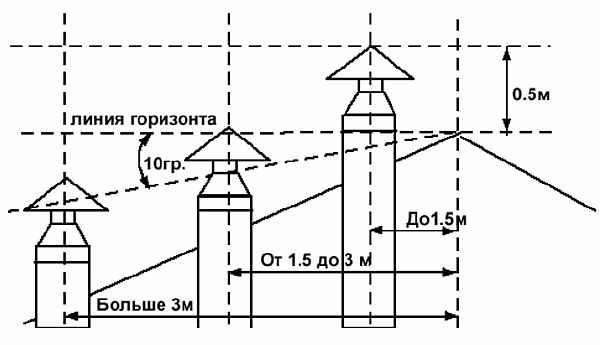

Failure to comply with these requirements is fraught with insufficient draft in the chimney with all the ensuing consequences.
- The chimney diameter is directly proportional to the boiler output. The most commonly used corrugation is 110 or 130 millimeters. But it is best to use the recommendation of the technical passport of the heating unit, where this parameter is indicated without fail.
- Climatic conditions for the operation of the gas unit in terms of the magnitude of the temperature difference in the boiler room and outside.
Can the corrugation be used as a cooker hood for a gas boiler?
The guest wrote: Yes, this corrugation has been standing for years and nothing happens to it! And stainless steel costs 10 times more, breed only people!
No, we think about your and our safety. If we install a corrugation in the installation, and something happens, who will be the last one? That's right, we will be responsible. And how many of these corrugations have already been burned out, you start dismantling, it falls apart in your hands. Only the presence of draft in the chimneys saved the owners. So think what is more important - life or wallet, as they say.
Chimney corrugation installation
The assembly of this simple structure must be done in the following order:
- Select a location for the heating unit so that the chimney is straight and vertical. This means that on its way the chimney should not encounter obstacles that need to be bypassed. This mainly applies to transfers on the interfloor overlap and rafter system.
- Install the elbow at the outlet of the boiler or gas water heater. Instead, flexible corrugations made of aluminum or stainless steel are allowed. It should be noted that this section is almost never insulated from the outside, since the temperature of the furnace gases in this place is high and condensation does not occur.
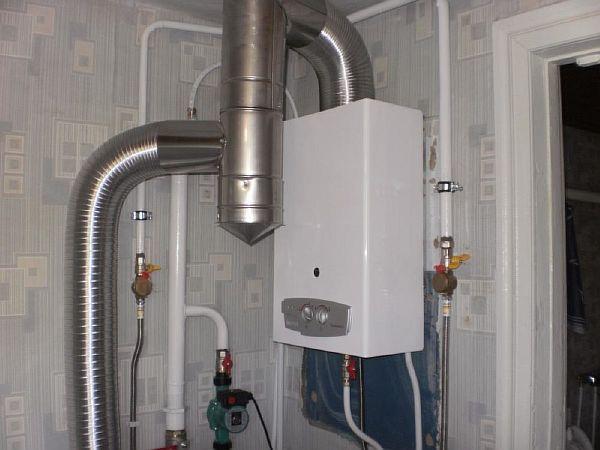

- Next, the installation of the straight section is carried out with the installation of clamps and fastening to the brackets (for a wall chimney).
- The outer part, which rises above the roof, is advisable to be made of a heat-insulated sandwich pipe, if necessary, install braces made of stainless or galvanized wire.
- Install a safety device in the form of a head on the pipe.


- Install the condensate trap.
Important! To ensure that condensate collects and does not get back into the firebox, the vertical part of the chimney must not be placed directly above it.
Repair of an old chimney with a corrugated pipe
The corrugated stainless steel pipe can be used not only for installation, but also for repairing an existing brick chimney. The repair does not take much time, the corrugated stainless steel pipe is simply inserted into the old chimney and connected to the boiler or fireplace.
As a result of the repair, the following positive points are noted:
- Reducing the amount of condensate, since a steel pipe heats up faster than a brick;
- Reducing the amount of soot on the pipe walls;
- Elimination of cracks. After several years of operation of the brick chimney, the tightness of the brickwork is lost and smoke begins to pour out of all the cracks. Casing the chimney with a corrugated pipe eliminates this disadvantage.
Design and types of corrugated pipes for chimneys
Corrugated chimney pipes are produced by cold forming on a special mandrel. Two types of materials are used for this purpose: aluminum-based alloys and stainless steel.
The workpiece is a tape about 50 millimeters wide with a thickness of 0.1 - 0.5 millimeters.
The corrugation was originally intended for use on air ducts of ventilation systems, where to this day it regularly performs its work. Attempts to use such pipes for chimneys were crowned with success, and since then this application has become more and more popular.
Can a gas corrugated chimney be used?
A chimney for a stove or boiler is, in fact, a very vulnerable part of the structure. Due to constant temperature fluctuations and the presence of toxic substances in the products of fuel processing, there is a high probability of destruction of the walls of the chimney. Brick systems are especially susceptible to this phenomenon. The only way out is to install steel chimneys, which are more durable and easier to install.
There are no obstacles to installing corrugated flexible products as a gas flue. With proper installation and operation, such systems can function no worse than smooth steel or asbestos-cement pipes.
The corrugated pipe is distinguished by its strength, which is achieved due to the following design features:
- its body looks like a cylindrical tube, twisted in a spiral. Spiral stripes are firmly connected with a lock seam;
- reinforcing wire creates a body - the base for the pipe, protecting it from mechanical damage and shock. This does not reduce the flexibility of the metal pipe.
Good to know! The possibility of using corrugated stainless steel pipes for gas is also mentioned in the regulatory documents SP 42-101-2003, as well as in the DBN V 2.5-20-2001 in force in Ukraine.
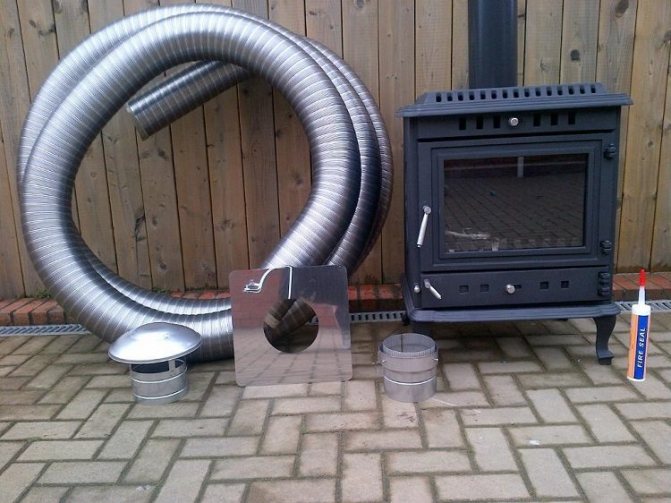

Flexible corrugated pipes can be used with different types of heating devices, including gas
Aluminum corrugation for chimneys
Aluminum alloys used in the manufacture of this type of product can withstand temperatures up to 500 degrees, after which the thin walls of these pipes burn out. But not only the temperature is important, but also the aggressive environment, represented by condensate, which is a weak solution of sulfuric acid.
In this regard, it is obvious that their use for this purpose is very limited. It is not recommended to install a corrugation on the chimneys of solid fuel boilers, where the temperature of the furnace gases is much higher and high-temperature agents are used to remove soot from the chimney. Corrugation is not used for fireplaces and solid fuel stoves on coal and wood.
Aluminum corrugated chimneys for gas boilers are still used quite actively, but specialists in gas and fire services are increasingly inclined to prohibit such structures.
Watch the video
A more loyal attitude to the corrugation on the chimneys of gas water heaters and electric fireplaces, since the temperature of the gases removed is lower than that of similar boilers.
Corrugated stainless steel
Heat-resistant corrugation is made of stainless steel using the same technology as aluminum. These pipes use a high-carbon steel reinforcing insert that is wound in the form of a spring. The spiral in the chimney increases the lateral strength of the products and prevents them from collapsing.
One of the features of corrugated products is their compactness. In the transport position, the length of the branch pipe is 65 centimeters, and after stretching along the longitudinal axis, it can reach three meters.
Watch the video
The temperature that the heat-resistant stainless steel corrugation can withstand is 900 degrees, which allows you to confidently use it for chimneys with any kind of boilers.
Pipes are produced in the range of diameters from 100 to 150 millimeters, the most used are sizes 110 and 130. Of the first, chimneys are mounted for boilers up to 19 kilowatts, large ones can be used for any more powerful heating units.
During installation, the corrugated pipe can be bent in the desired direction at an angle of up to 180 degrees, which is an undoubted advantage, since it allows you to do without the use of a large number of fittings.
To increase the service life, the stainless steel is treated from the inside with special compounds. Reacting with metal, they form a strong, chemically resistant cladding film on the surface. In this state, the corrugated chimney can serve up to 20 years. Fireproof corrugation is the most reliable material for fume extraction.
Installation instructions
The installation of a chimney is not much different from the installation of a similar device made of stainless steel pipes. But there are certain points that need to be considered:
- There is no need to think about the selection of the chimney diameter - the corrugated pipe must match the size of the boiler outlet.
- Having a thin wall, the corrugation loses a large amount of heat from the flue gases. Therefore, the chimney must be insulated along its entire length (except for the outlet pipe).


- Narrowing of the smoke channel is not allowed, its size must be stable along its entire length.
- During installation, use adapters for special purposes only. The use of other products for docking is fraught with loss of tightness, and this is the main requirement for the chimney.
- The use of a corrugation provides for the mandatory installation of a condensate collector, otherwise its inevitably quick planting.
- When connecting separate parts of the chimney, in addition to clamps, additional seals must be installed. Good results are obtained by using a high temperature sealant.
Using these rules, you can qualitatively install an effective, and - most importantly - safe in all respects, chimney.
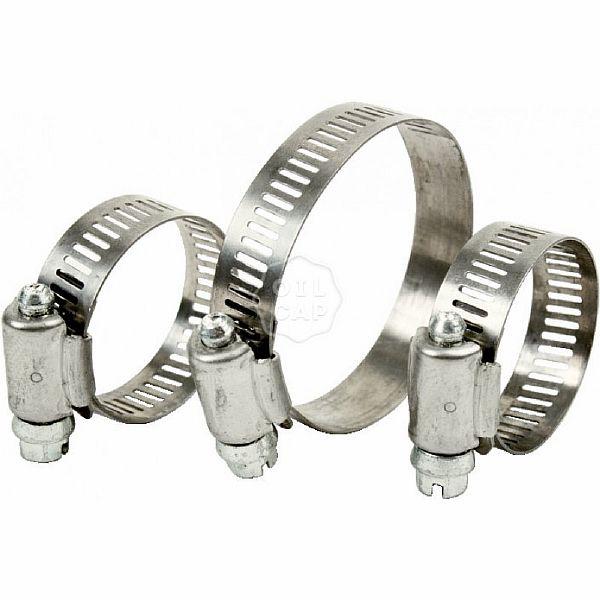

Tips & Tricks
- It is undesirable to use an aluminum corrugated pipe for chimneys of solid fuel boilers. And for gas appliances, including a column, it is better to avoid risk and use fire-resistant stainless steel. The gas corrugation is fire hazardous.
- If the corrugation is released outside through a brick chimney, assembly is done from above. At the same time, a strong rope is tied at the lower end. In this way, working together, you can quickly and easily plug the chimney with a corrugation. A flexible stainless steel chimney is fed through the mouth of the pipe, and the second participant in the process pulls the corrugation from below.
- When installing an external (wall) chimney, no more than two bends are allowed. If necessary, it is better to perform them at an angle of 45 degrees.
- When installing a steel corrugation for a boiler in an old chimney, you need to carefully cover the stove with a wet cloth and close all technological holes in it. This is necessary to prevent the ingress of soot into the living area of the house.
- Before installing the pipe in the old chimney, it is necessary to thoroughly clean it from soot deposits on the walls.
Features of flexible chimneys
The flexible chimney is a round, hollow profile. For the manufacture of such a pipe, sheet metal rolled into a spiral is connected using a lock seam.
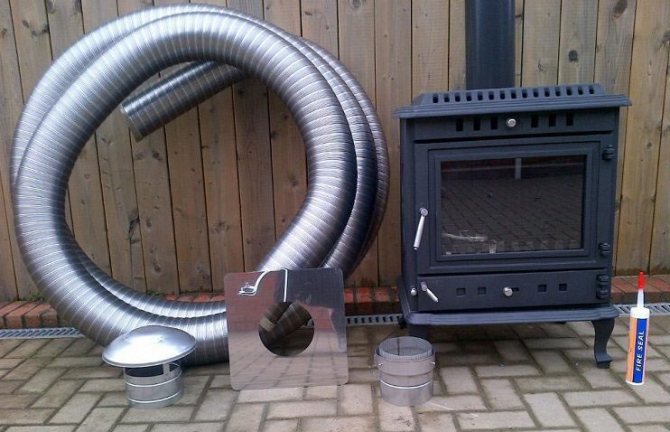

The structure of the product differs in that a steel wire is inserted between the metal layers, thanks to which the pipes acquire such properties as flexibility and strength. They have different cross-sectional sizes, but the most common are pipes with a diameter of 110 - 300 mm.
Each part of the pipe is 65 centimeters long, but it can be easily extended up to 3 meters. The flexibility allows the chimney to be installed with different bends and many bends. The wall thickness varies from 0.25 to 1 mm.
The corrugated pipe can be used to equip a part of the chimney (passage through a wall or ceiling, as well as when reconstructing an indirect brick chimney) or for installing the entire chimney duct.
Note! It is recommended to install a corrugated chimney to a heating system operating on different fuels with high or low temperature flue gases.
Reliability is ensured due to the following properties:
- cylindrical spiral shape with a locking connecting seam;
- a reinforcing layer in the form of a wire, which makes the body more resistant to mechanical damage, but retains the flexibility and elasticity of the product.
By the type of strength, light, heavy and superheavy pipes are distinguished.
We recommend that you familiarize yourself with: How to make and install a protective exhaust hood on a chimney
CORRUGATED CHIMNEYS FOR GAS BOILERS
It is possible to use a flexible metal chimney corrugation for a gas boiler, as well as any other heating equipment, due to the high technical characteristics of the material. In this case, it is worth considering several important aspects:
- Aluminum pipes can burn out after several years of operation. Therefore, if there is a need to connect a corrugated chimney, it is better to choose a sleeve made of stainless steel.
- The material has poor heat-saving characteristics. To reduce the production of condensate, you will need to make heat and sound insulation on the corrugated pipe. To do this, you can use a non-combustible mineral insulation 5 cm thick. The thermal insulation is wound on a pipe, and covered with any foil reflector on top. Fix with knitting wire.
- To connect pipe sections of different diameters, use special adapters.
The rules allow the use of aluminum corrugated pipes in the chimneys of condensing gas boilers, due to the low temperature of the exhaust flue gases. But for more safety, it is better to choose a stainless steel pipe.
Requirements for the installation of chimneys
For the high-quality operation of the chimney, it is necessary to comply with a number of requirements during installation, entirely aimed at increasing the efficiency of the structure.
The basic requirements are as follows:
- Fasteners must be carried out using adapters;
- The inner diameter of the chimney must match the diameter of the outlet from the heater;
- The corrugated pipe must be wrapped in a layer of non-combustible material at the place of passage through the roof and walls - this allows a high degree of fire safety to be achieved;
- The outer protective casing must be two-layer, so that in case of damage to the outer layer, the chimney remains intact;
- The pipe must be attached to the heating system hermetically so that the gas does not go outside the structure;
- The section of the channel located between the lower part of the branch pipe and the horizontal section of the chimney must have a length of at least 50 cm;
- The bending radius of the corrugated pipe during installation must be equal to or greater than the diameter of the material;
- There must be a gap of more than 5 cm between the walls or ceiling and the pipe;
- If the nearest surfaces are made of combustible materials, then the gap between them and the pipe must exceed 25 cm;
- The total length of pipes laid horizontally must be less than three meters;
- The boiler must be connected vertically;
- The flexible chimney is installed at a slope greater than 0.01 degrees relative to the gas equipment.
Types of corrugated pipes for chimneys
The market today is almost oversaturated with a variety of types of corrugated pipes. Of course, not all of them are suitable for arranging chimneys - there are certain safety requirements that must be followed without fail. Only stainless and aluminum corrugated pipe meets the stated requirements.
More recently, only aluminum products were used for the installation of chimneys. Structurally, they were laminated foil, laid in several layers - this is how a corrugated pipe for a chimney with a diameter of about 10-15 cm was formed. The structure could not maintain its original shape on its own, therefore, there was a steel wire inside.
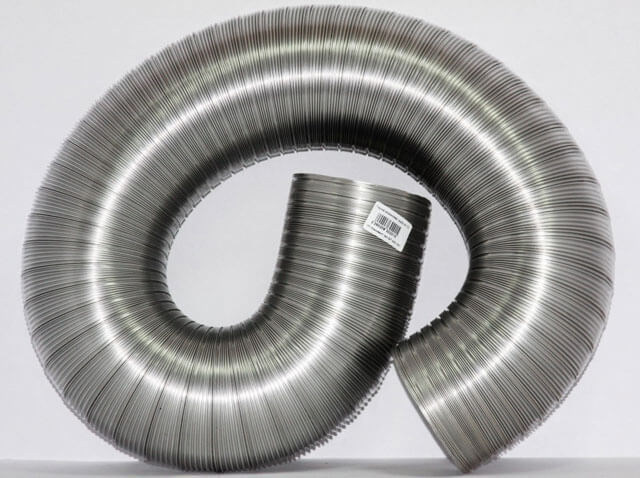

It is impossible to use such devices in conjunction with solid fuel heat sources - the chimney from an aluminum pipe cannot work in conditions of direct contact with high temperatures.Now chimneys made of this material are not recommended for use.
Corrugated stainless steel chimney pipe is visually similar to aluminum, but this is where the similarities end. The main difference is the ability to withstand temperatures up to 900 degrees without damage and deterioration of the efficiency of removal of combustion products.
Benefits of a corrugated chimney
The chimney corrugation has some advantages over its classic counterparts. So:
- The corrugated pipe for the chimney heats up evenly, avoiding the appearance of moisture on the walls.
- The chimney is flexible, which allows you to assemble a structure of absolutely any configuration and shape, and at the same time, the corrugated pipe does not require additional fasteners and connections.
- The stainless steel pipe has a monolithic surface, which provides better sealing.
- For a roof, a flexible chimney is more preferable, no additional work is required to dismantle walls, partitions.
- Corrugation can be used not only for the stove, but also for fireplaces, boilers, columns. It can also be used to organize ventilation.
Corrugation application
The area of application of corrugated pipes is quite extensive. Some time ago, aluminum corrugations were used in the construction of chimneys for gas heating boilers and water heaters.
But, given their performance characteristics, experts recommend abandoning the use of aluminum corrugation in this capacity. This material will serve as an excellent option for arranging an air outlet in a ventilation system.
Corrugated stainless steel is used in the heating system. In this case, it does not matter what fuel the heating equipment operates on. It is mounted when installing a stove, heating boilers, fireplaces, boilers. Moreover, its sphere of action is unlimited. It can be installed both with external exhaust systems and with internal ones.
Such structures are also used for casing in the event that it becomes necessary to repair a brick chimney with existing bends. In addition, the steel corrugation can serve as an adapter connecting the chimney and the outlet. In a hood with straight steel pipes, elbows are mounted using corrugations.
This material finds its application in the arrangement of underfloor heating, water supply systems, in split systems for gas distribution.
Today, corrugated steel pipes are used both in industrial premises and in the private sector. In addition, they are increasingly used in the medical and chemical industries, in agriculture.
Types of corrugated chimneys
Today, the corrugated chimney is divided into two subspecies, according to the material of manufacture:
- Metallic steel.
- Aluminum corrugation.
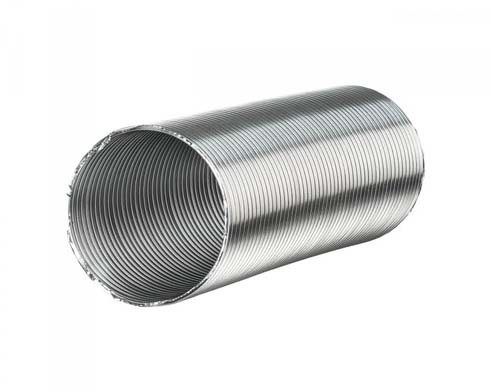

Aluminum corrugation
For the first type, wear-resistant, heat-resistant, stainless steel is selected. Corrugated stainless steel stove chimney is much more common, due to some of its features. First of all, durability and stability. An aluminum pipe is more suitable for organizing ventilation or for removing gases from columns and gas boilers.
Pipe installation
Before installing the corrugated chimney, it is necessary to prepare all the material and tools. These include:
- directly the corrugation itself of the required section and length;
- metal brackets;
- metal tape;
- adapters;
- rubber seals;
- roller pipe cutter or grinder.
Despite the ease of installation of the chimney corrugation, its installation requires compliance with certain rules. After all, it serves as a channel for the removal of carbon monoxide gases formed during combustion.
- The diameter of the pipe must match the diameter of the outlet of the heating appliance.
- When moving between floors, you must use a fireproof case.
- The fastening must be done tightly.All parts are tightly connected to each other, gaps are unacceptable.
- Chimneys cannot be installed in residential premises. It is also forbidden to bring these channels to closed loggias or balconies.
- When passing the pipe through the stefnos or the ceiling, an apron made of a metal plate laid on a sheet of asbestos must be installed.
- In the event that the wall or ceiling is made of fireproof materials, the distance between their surfaces and the pipe must be at least 5 cm.When combustible materials are used in the construction of a house, this parameter increases to 25 cm.A distance of 10 cm is allowed, but in this case the wall surface should be insulated with a steel plate placed on a 3mm thick asbestos sheet. In this case, it should protrude 15 cm beyond the edges of the pipe.
- It is prohibited to install an umbrella on the chimney of a gas heater.
- Sagging of the corrugation is not allowed.
Installation begins with the connection of the corrugated structure to the outlet channel of the heating device using rubber seals. Its edge should be smooth without burrs.
With metal brackets, the corrugation is attached to the wall in a vertical position. The elements are fixed between themselves with metal tape. For different pipe diameters, special adapters are used during the connection.
In the event that the corrugation is brought out into a ready-made brick chimney, a hole is made in the wall along the diameter of the pipe.
One end of it is connected directly to the heating device, the other is led out into the wall with a bend. A metal apron must be made around the corrugation.

